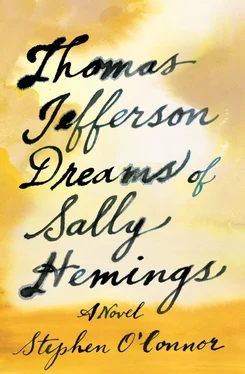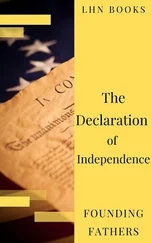And then Thomas Jefferson is walking upon a breeze, into the heart of Sally Hemings, who sleeps beside her mother in the cabin he might see from his bedroom window were he to rise from his not-sleep and part the curtain. Her brow, in the gray moonlight, is darkened by a cluster of V-shaped dents, and her heart is entirely occupied by the desire to get something right. It is her invention, which is constantly falling apart, and must constantly be reconstructed. The parts slip between her fingers and roll across the floor. She darts after them, sweeps them up, but she is never sure she has gotten all of them, so is never sure if her invention, once it is reassembled, will actually work. But it is never reassembled, because as she works to bolt one part to the next and the next, still other parts are falling to the floor and rolling into corners. Always. Always. Always.
And then Thomas Jefferson has passed through her heart into another within her body that although it has only just commenced beating is already possessed of a yearning so relentless it might destroy the world.
This is what Thomas Jefferson thinks: Sally Hemings has no African in her, except perhaps in the barely noticeable fullness of her upper lip and in the rondure of the tip of her nose — though, indeed, precisely these traits can also be found in people of the purest British stock. The blood of Captain Hemings and, even more so, that of Thomas Jefferson’s own father-in-law, John Wayles, has entirely overwhelmed the necessarily less robust African blood to which she might have been heir. As a result she has inherited none of the less savory traits of the race.
Although she has had no formal education, her mind is as sharp as that of any woman Thomas Jefferson has ever known, particularly in regard to her judgment of people. Her assessment of Tom Randolph, for example, has proved sadly accurate. He is just exactly as unsure of himself as she hypothesized during his first brief visit in Paris and exactly as prone to countering his weakness of character through a spiteful coldness that he fancies as dignity. There is also something vengeful in his indulgence of cider and whiskey, and poor Martha seems to be the one who most has to suffer from it. But Sally Hemings is also a shrewd judge of people she has never met. Thomas Jefferson had hardly said ten words about Alexander Hamilton before she’d pegged him as having the conscience of a rattlesnake, and Carter Braxton as a buffoon and a would-be confidence man.
Needless to say, Sally Hemings also lacks that sluggishness of the kidneys that inclines Negroes toward indolence and excessive sweating, and her skin is no more sable than a bowl of milk into which a tincture of molasses has been diffused.
This temperate evening in mid-September, Thomas Jefferson is the one who is sweat-drenched and black of face and hands, while Sally Hemings is seated in the open air outside her cabin, taking advantage of the waning sun to embroider a tiny nightcap.
He has decided that the proportions of his house are entirely lacking in grace and that he must extend it on both the north and south and replace the top floor with a dome. For six weeks he has been attempting to come up with the right combination of clay, sand, water and heat to produce durable bricks, and just this afternoon he made the first batch that neither exploded in the kiln nor turned to grit on the application of the least weight. He is happy as he walks, soot-blackened and smelling of charcoal, along Mulberry Row back toward his house. When he has amassed a suitable number of bricks — by the spring, ideally — the new construction can begin.
Sally Hemings is so immersed in her work that she does not see him, even though he is only a few steps away. She is seated with her back partly turned to the sun so that it might better light her sewing. Her cheek and shoulder are gilded with it, and her loose dark hair is streaked with auburn glints. She is seven and a half months pregnant, and her forearms rest lightly on the sides of her enormous belly.
He stops walking. He will stand in the road until she looks up and notices him. Every time she pushes her needle through the gathered cloth, she purses her lips, and as she pulls the thread through, she tilts her head slowly to the left, then straightens it and repurses her lips as she prepares to jab the needle into the cloth another time. It is true that these little motions make her look ridiculous, but even so, Thomas Jefferson has never seen her more beautiful.
As Thomas Jefferson contemplates the identity of color, which can never be separated from the relationship between colors, he also contemplates the relationship between horror, consolation and beauty. Since his arrival in New York City, he has been thinking about Rilke’s notion that beauty is “nothing but the beginning of terror,” which he interprets to mean that we feel beauty most intensely in the presence of that which, if only by its transcendent magnificence, would seem capable of destroying us and yet does nothing of the kind. Our fear combined with our sense that we have nothing to fear translates into the sort of elevation we call beauty.
For most of his adult life, he has applied this notion primarily to the beauty of such things as mountains and dazzlingly starry skies. But lately he has been thinking about those instances when he has experienced joy of such terrific intensity that it is barely distinguishable from sorrow. In every case the joy has arisen out of the simultaneity of two contradictory impressions. The first took him years to recognize, because it is so at odds with the sort of person he has always wanted to be and who, even now, he tends to think that he actually is. He wants to be an idealist and an optimist, but, in fact, at the deepest level of his being, he sees ideals as nothing more than sad delusions and existence as the theater in which we are shown our utter selfishness, perversity and insignificance. And thus when he perceives, against the backdrop of this grim conviction, even the smallest instance of human decency — an act of simple kindness, for example — he experiences such an upwelling of joy that it is all he can do to hold back tears. Every time it’s exactly the same: our earthly loathsomeness intersecting with a minute or fleeting suggestion that we might not be entirely damnable — nothing else fills Thomas Jefferson with such joy or seems so profoundly beautiful.
This beauty is, of course, consolatory — but not falsely so. An instance of beauty endures only so long as it seems manifestly real and true. At the faintest tremor of doubt, it reverts to sad delusion or to hypocrisy. And so as he walks the streets of New York City and rides in metal boxes underground, among glum and oblivious strangers, Thomas Jefferson has come to define beauty as that which gives us joy without blinding us to truth.
But what about the beauty of color? When we get lost in that deep red, which is also red next to zenith-blue, and red and blue together beside a matte gold-brown — do we secretly feel ourselves to be truly lost and so become afraid? And do we then experience a sort of consolation insofar as we know that we are not, in fact, lost, that a mere blink is enough to liberate us from that complex red and restore us to our world of nothing much, in which we feel at home? Or is the beauty of color only the product of color’s simplicity, of the fact that it is entirely uninflected by selfishness and perversity, or by morality and meaning, and that when we are lost within it, it is only itself and we are only ourselves, happily, childishly and deeply alive in our being? Is color so beautiful simply because it is perfectly innocent and pure?
… I engaged in a constant debate with myself, arguing that Mr. Jefferson merely suffered from the white man’s constitutional incapacity to speak sensibly on matters of slavery or race, but that even so he was a good man, a brilliant man, a sad and kind man, and he loved me deeply. I am lucky, I would tell myself. I am very lucky.
Читать дальше












